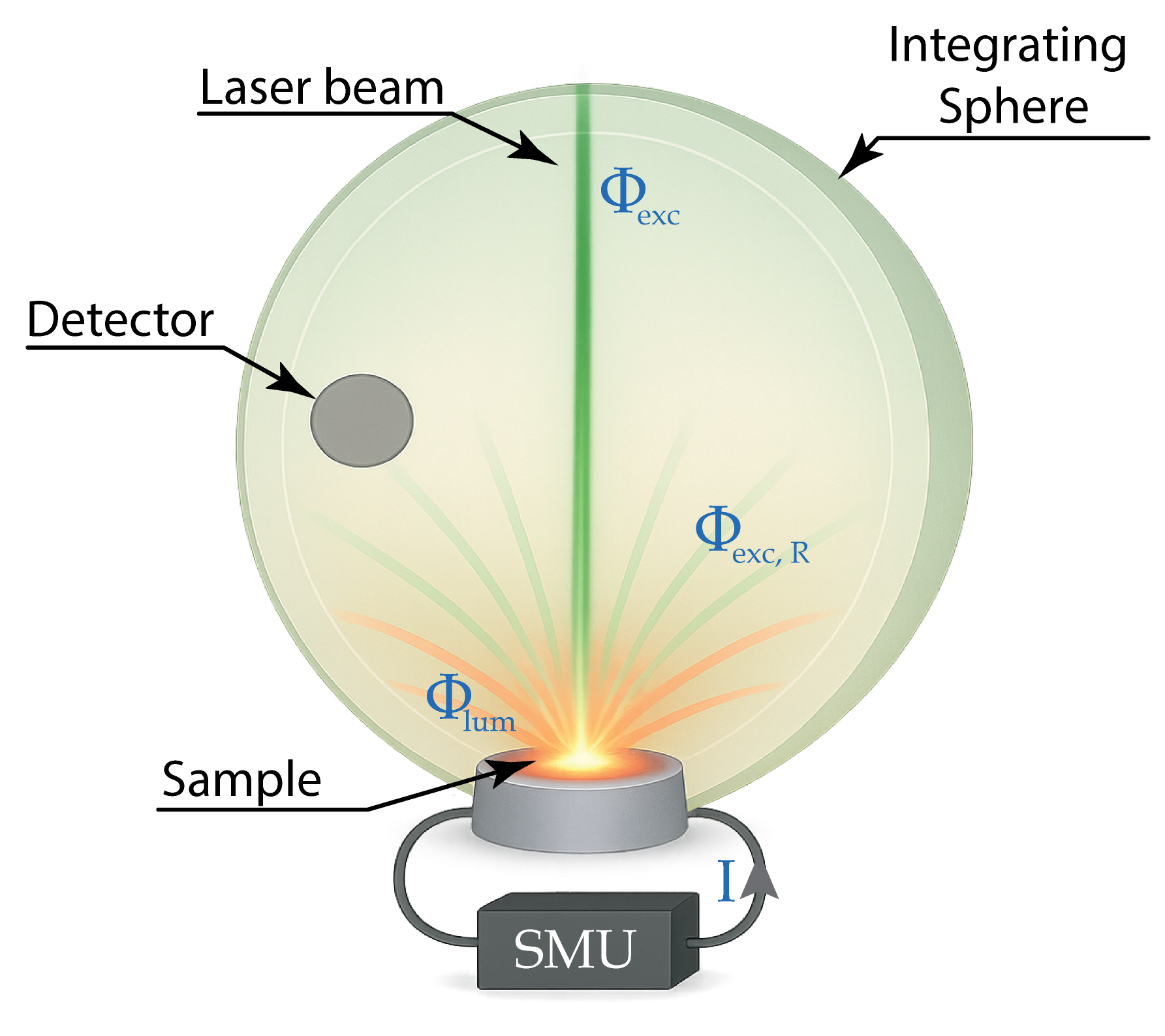LuQY Pro – Theory
Absolute PL/EL – the gold standard for quantifying recombination losses in semiconductors.
Absolute photoluminescence (PL) and electroluminescence (EL) are methods that quantify the quality of semiconductors. Unlike relative measurements, absolute techniques yield precise values of the external quantum yield that can be directly compared across laboratories and experimental conditions.

LuQY calculation of electro-/ photoluminescence quantum yield
The external luminescence quantum yield (LuQY) — also denoted as electro-/ photoluminescence quantum yield ELQY / PLQY or external quantum yield ηext — is a fundamental figure of merit for optoelectronic materials. It is defined as the ratio of emitted to absorbed photons.
Hover over the terms in the equation below to see detailed definitions.
Also denoted as ELQY, PLQY, ηext = Φlum ∫0∞ φlum(E) dE — total emitted photon flux
φlum(E): Absolute PL/EL photon flux density [photons·s⁻¹·eV⁻¹] Φexc ∫0∞ φexc(E) dE — total excitation photon flux
φexc(E): spectral excitation photon flux density (laser input, in LuQY Pro) − Φexc,R ∫0∞ φexc,R(E) dE — total reflected/unabsorbed flux
φexc,R(E): spectral reflected photon flux density (reflected laser in LuQY Pro) + ISMU ISMU
Current sourced by the Source-Measure Unit
Here: Φlum is the total emitted photon flux (absolute PL/EL), Φexc is the incoming laser excitation flux (in LuQY Pro), Φexc,R is the reflected or non-absorbed laser flux (in LuQY Pro), and ISMU is the current sourced by the source-measure unit. All photon fluxes Φ are obtained by integrating the corresponding spectral photon flux densities φ(E) over energy.
Note that current sinking is not included in the LuQY calculation; consequently, under short-circuit conditions LuQY appears lower than under open-circuit conditions due to luminescence quenching by charge extraction.
Quasi-Fermi level splitting (QFLS) prediction
The quasi-Fermi level splitting (QFLS) represents the maximum achievable open-circuit voltage (VOC) of a solar cell. It directly reflects the fundamental material quality: higher QFLS values indicate reduced recombination losses and improved device efficiency.
One powerful way to extract the QFLS is by applying a High-Energy Tail (HET) fit to the absolute PL or EL emission spectrum. This approach analyzes the exponential decay of the emission at higher photon energies, where it follows a Boltzmann-type distribution.
\[ \ln \left( \frac{\varphi_{lum}(E) \cdot h^{3}c^{2}}{2\pi E^{2} a(E)} \right) = - \frac{E - QFLS}{kT} \]
Where:
-
φlumE) – absolute PL/EL flux density
-
E – photon energy
-
h – Planck’s constant
-
c – speed of light
-
a(E) – absorptance of the sample
-
k – Boltzmann constant
-
T – Temperature of electron gas
By fitting the high-energy slope of the emission spectrum with this equation, the intercept with the energy axis yields the QFLS, providing a direct link between the measured luminescence and the electronic quality of the material.

Calibrations traceable to international standards (NPL, PTB, LNE, NIST).
Absolute calibration of the system
Prerequisite for the high energy tail fit method is a calibration of the entire measurement system to absolute photon numbers (absolute PL / absolute EL).
The laser intensity of the LuQY Pro is calibrated to absolute photon numbers against certified power meters. The spectral sensitivity of the LuQY Pro is calibrated to absolute photon numbers against certified reference lamps with known luminous flux as well as against different lasers with intensities determined by a certified power meter.
All measurement equipment used for calibration is traceable to national standards of the ‘EUROMET’ members (NPL, PTB, LNE etc.), the US ‘NIST’ or other national metrological institutions. Measurements which cannot be traced to national standards can be traced to natural constants, other accepted standards or relational measurements. All calibrations are valid for one year.
More details on absolute PL / EL analysis can be found here:
[1] Unold, T.; Gütay, L. Photoluminescence Analysis of Thin-Film Solar Cells. In Advanced Characterization Techniques for Thin Film Solar Cells; Wiley-VCH Verlag GmbH & Co. KGaA, 2011; pp 151–175.
[2] Kirchartz, T.; Márquez, J. A.; Stolterfoht, M.; Unold, T. Photoluminescence‐Based Characterization of Halide Perovskites for Photovoltaics. Adv. Energy Mater. 2020, 1904134.
[3] Swartz, C.; Paul, S.; Mansfield, L.; Holtz, M. Absolute photoluminescence intensity in thin film solar cells. Journal of Applied Physics 125, 053103, 2019.

